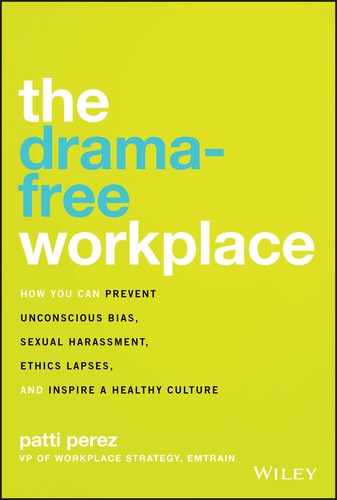Appendix
Supporting Documents for Conducting Investigations
This appendix includes checklists and worksheets that you can use to investigate and resolve claims of workplace misconduct. Included are:
- An Investigation Strategy worksheet for keeping track of investigation steps.
- An Interview Notes Cover Page that gives you a place to record information about a witness you are interviewing and a checklist of statements to make at the beginning and end of each interview.
- Sample Conclusion Language. You can use the language found here to state your findings clearly and precisely.
INVESTIGATION STRATEGY
General Information
Matter Name: ________________________________________
Matter #: ________________________________________
Matter Type: ________________________________________
Investigator: ________________________________________
Immediate Remedial Action Taken: ________________________
___________________________________________________
___________________________________________________
Checklist
- Review written complaint or other written statements regarding allegations. Documents reviewed: _____________________________________________________
_____________________________________________________ - Review relevant company policies and procedures. Policies reviewed: _____
_____________________________________________________ - Review complainant’s and alleged wrongdoer’s personnel files.
Potential Witnesses

Documents to Review

Other Notes

INTERVIEW NOTES COVER PAGE
General Information
Witness’s Name: ____________________________________
Documents Provided by Witness: □ Yes □ No
Date of Interview: ____________________________________
Interview Location: ____________________________________
Start Time/End Time: _________________/__________________
Investigator’s Name: ____________________________________
Other Representatives Present (including relationship): _____________
____________________________________________________
Introduction
- Explain the investigation scope; disclose only necessary information about allegations.
- Explain the company policy on the subject matter, if applicable.
- Explain the investigation process.
- Explain your role in the investigation.
- Explain that witness cooperation is important.
- Address confidentiality and its limits.
- Stress retaliation prohibition: All are protected and bound.
- Explain the importance of being completely honest and open.
Witness Background
Position/Title: ____________________________________________
Department: _____________________________________________
Direct Supervisor: _________________________________________
Date of Hire/How Long with Company: _________________________
Witness’s General Description of the Workplace: ___________________
______________________________________________________
______________________________________________________
SEE ATTACHED PAGES (___ pages in total) FOR DETAILED INTERVIEW QUESTIONS AND RELATED NOTES
Closing the Interview
- Ask, “Is there anything else that we haven’t discussed that you believe will be helpful to me?”
- Stress that retaliation is strictly prohibited. Remind witness to report any retaliation.
- Inform witness that s/he may need to be contacted for additional information.
Sample Conclusion Language
Though not intended to be a script for the formulation of a written conclusion to an investigation, this sample language is intended to be an illustration of the various ways in which conclusions can be drafted, depending on the type of findings or severity of behavior found in an investigation. The nuanced analysis will vary depending on the specific facts of and individuals involved in the investigation.
Sample Conclusion Language
| Finding | Practice Tips | Sample Language |
| Allegations Substantiated | This conclusion might be reached because there is proof that the behavior occurred (an admission by the wrongdoer; emails or other documents confirming the events/behavior; corroborating testimony, etc.) or because a careful and reasonable review of all the evidence (sometimes circumstantial) makes it more likely than not that the behavior in fact occurred. As is true with all conclusions, they should be stated as factual conclusions (not legal conclusions) and should be based on the evidence presented. (For easier reference, the sample language refers to “harassment” recognizing that this is the language used by many employees and often an analysis will be made using the policy. The use of those legal phrases does not imply illegality and, as suggested throughout this book, you should refrain from using legal language whenever possible.) |
|
| Allegations Unsubstantiated | In some instances, the allegations are not supported by the evidence. In this case, the complainant might have a reasonable belief of wrongdoing, but his/her perceptions are simply not supported by the evidence presented (note that this is very different than a “false claim”—that implies a complainant made up facts maliciously). In such a case, investigators need not directly attack the complainant, but rather base the conclusions on the fact that the objective evidence simply does not support his/her allegations. |
|
| Some Allegations Substantiated | Often the investigator will find that the evidence suggests that the complainant’s allegations did not occur as reported but there still might be a finding that some of the allegations are substantiated and that the accused fell below the expected behavioral standard. In some cases, the investigator might find that the allegations occurred as stated (in fact, some investigations involve descriptions of events with no factual variations), but that perceptions and interpretations of the events diverge. (Of course, when any witness’s credibility is called into question, this should be noted in the verbal and/or written conclusions.) |
|
| “Inconclusive” Findings | Though it should be extremely rare, there will be an occasional situation where you simply do not have enough evidence (despite your best attempts to collect it) to allow you to reach a reasonable and fair conclusion. In this case, investigators should be meticulous about reciting the facts as presented by the various witnesses (and by the documentary evidence, if appropriate), but should also clearly state that the evidence is insufficient to reach a conclusion one way or the other. |
|
| “Learning Lessons” | Regardless of the conclusion, almost all investigations present facts or circumstances that provide some learning lessons. Investigators should not be afraid to point out ways in which behavior, policies, or practices could be improved. For example, in some instances, even if there is insufficient evidence to support the allegations, individuals may benefit from coaching/training, or the business might benefit from the implementation of procedures to improve effectiveness and/efficiency or the company might benefit from the implementation of new or improved policies. Incorporating forward-looking accountability is a key way to keep drama out of the workplace. (For more on the concept of forward-looking accountability, see Chapter 5.) |
|
